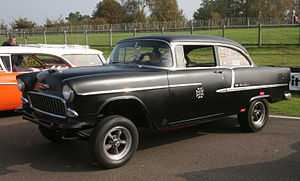Gasser (car)
.jpg)
A gasser is a type of hot rod originating on the dragstrips of the United States in the late 1950s and continued until the early 1970s.[1][2] Gassers are based on production models from the 1930s to mid-1960s, which have been stripped of extraneous weight and jacked up using a beam axle to provide better weight distribution on acceleration (beam axles are also lighter than an independent front suspension), though a raised stock front suspension is common as well. Common weight reduction techniques include fiberglass body panels, stripped interiors and plexiglass windows (sometimes color tinted).
Engine
Because they were primarily built for racing, these cars typically had the engine swapped to a larger or more powerful one, or the existing stock engine modified (often heavily). It was very common to fit a Roots supercharger and mechanical fuel injection, such as one from Algon, Hilborn, or Crower.
Suspension

With form being dictated by function, their appearance is often very top heavy and ungainly, largely due to front ends being raised higher than stock, to assist in the weight transfer during rapid acceleration (racing).[1] Having their exhaust pipes exit through the front fender well is a common characteristic of gassers , as is having bodies painted in flamboyant metalflakes, pearls, and candy finishes complemented by lettering in wild fonts.
Name
The name arose because they competed in a gasoline-fueled drag racing class, rather than one using methanol or nitromethane.
The gasser is the predecessor of the modern funny car.
References
- ↑ 1.0 1.1 Jeff Breitenstein. Ultimate Hot Rod Dictionary: A-Bombs to Zoomies. MotorBooks International. pp. 96–. ISBN 978-1-61059-235-2.
- ↑ Bob McClurg (2013). Diggers, Funnies, Gassers and Altereds: Drag Racing's Golden Age. CarTech Inc. pp. 70–. ISBN 978-1-61325-105-8.
Further reading
- Larry Davis (1 August 2007). Gasser Wars: Drag Racing's Street Classes, 1955-1968. CarTech, Incorporated. ISBN 978-1-932494-66-2.
- Steve Magnante (1 January 2010). How to Build Altered Wheelbase Cars. CarTech Inc. ISBN 978-1-934709-26-9.
| ||||||||||||||||||